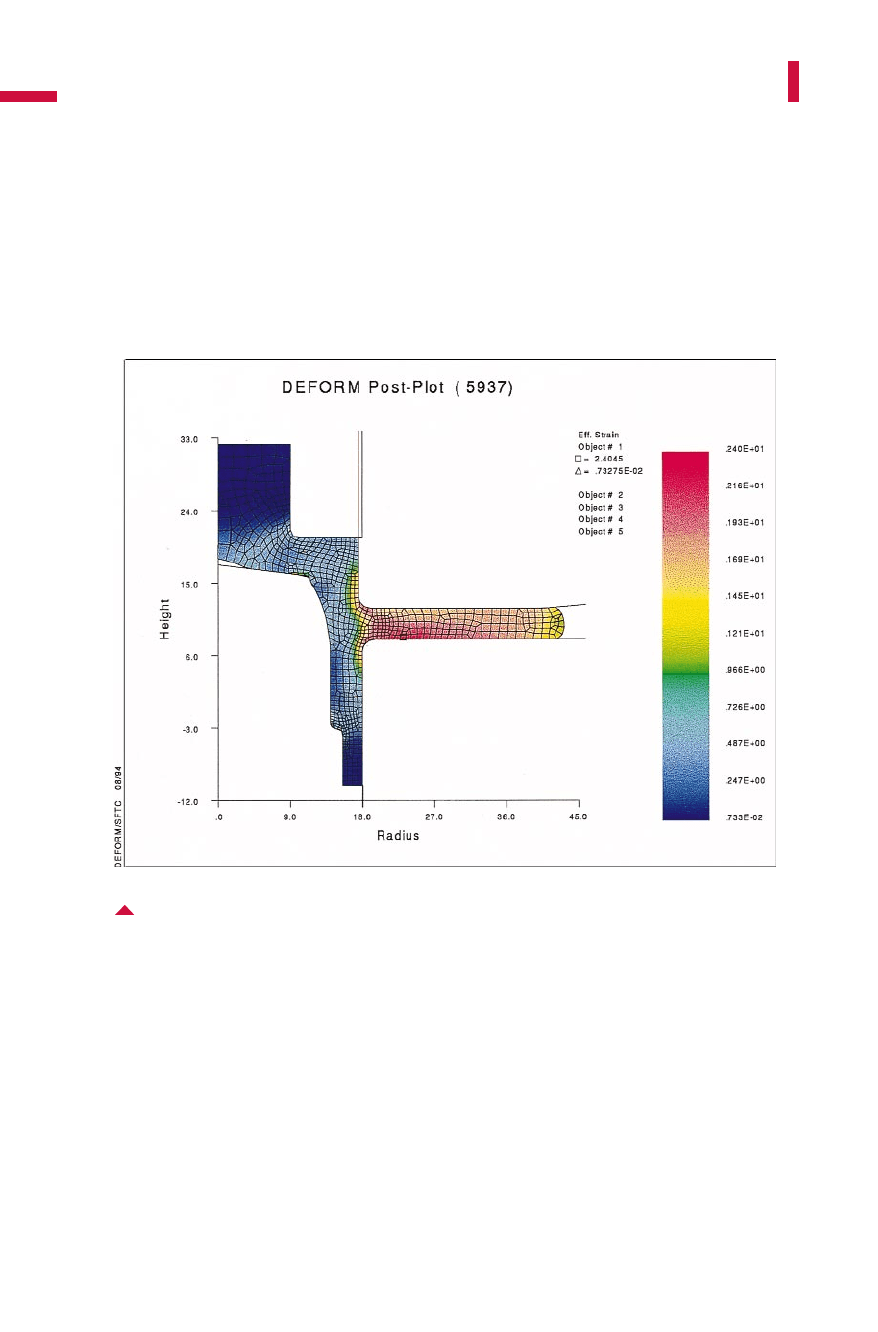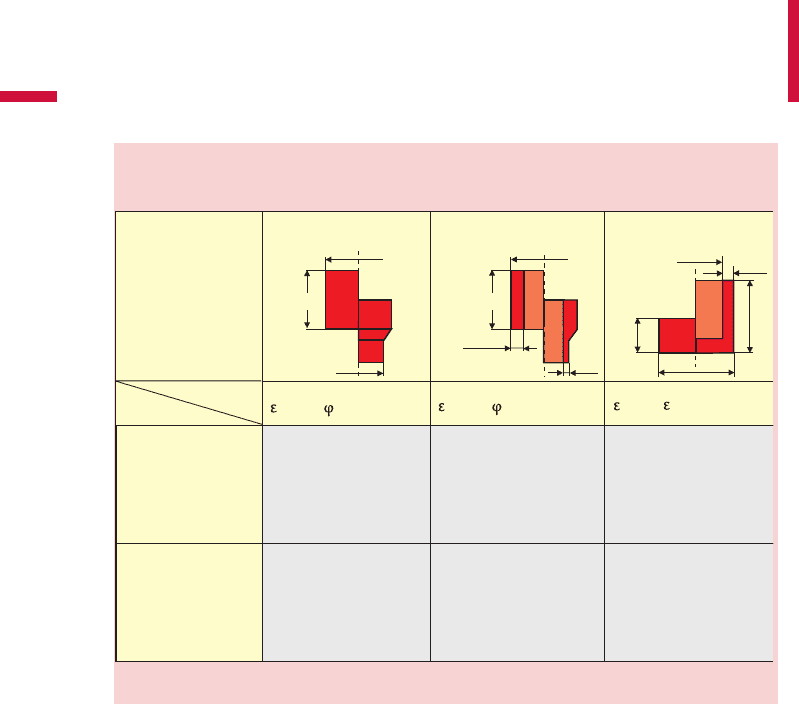Altan T. Metal Forming Handbook
Подождите немного. Документ загружается.


iron phosphate layers are used. Phosphoric acid, zinc phosphate and
oxidizing agents are applied in an aqueous solution. On immersion in
the solution, the metal surface is pickled by the phosphoric acid, during
which process insoluble zinc sulphate is simultaneously precipitated.
The chemical reaction does not come to a standstill until the complete
surface is coated with zinc phosphate crystals. The oxidizing agent
transforms the dissolved metal to a phosphate with low solubility which
is precipitated in the form of sludge and has to be removed periodically.
In practice, phosphate layers with a mean thickness of around 8 to
15mm are applied, which leave behind a shiny coating after forming.
The phosphate layer can resist temperatures up to 200 °C. Over 200 °C,
a partial transformation takes place. At over 450 °C, complete decom-
position of the phosphate layer takes place. Depending on the lubricant
used, however, working temperatures of up to 300 °C can be realized
during forging.
Soaping and molycoting
Soaping takes place by immersion of the parts in an alkaline soap solu-
tion. The main component of these solutions is sodium stearate. A part
of the zinc phosphate layer reacts with the sodium soap to form a water-
insoluble zinc soap layer. The zinc soap is additionally coated with the
sodium soap. This combination of layers has a very low shear strength
and thus reduces the effective coefficients of friction (cf. Sect. 4.2.3).
Soaping should not take longer than 5 min, as otherwise the entire phos-
phate layer will be used up and no longer provide an adhesive substrate.
To make sure that the soap coating offers good lubrication properties
it is necessary to dry the coated billets completely. A waiting period of
one day previous to processing of the treated blanks is usually recom-
mended. The soaps are temperature-resistant to approx. 250 °C, above
which chemical transformation processes take place. Excessive soaping
results in soap deposits building up on the dies.
Molybdenum disulphide is used under difficult forming conditions.
Compared to soap lubricants, molybdenum disulphide causes greater
friction losses which mean that larger press and ejector forces have to
be taken into consideration. However, it is capable of withstanding far
greater levels of stress, i.e. the lubricant film only breaks away under
extremely high degrees of surface pressure, and permits considerable
surface expansion of the workpiece. Therefore, molybdenum disul-
461
Materials, billet production and surface treatment
Metal Forming Handbook / Schuler (c) Springer-Verlag Berlin Heidelberg 1998

phide is used when large deformations, i.e. large true strains, are pre-
sent. In addition, molybdenum disulphide creates fewer problems as
regards the accumulation of surplus lubricant in the dies. The upper
application temperature limit is around 350 °C. At higher temperatures,
molybdenum trisulphide is created, which is ineffective as a lubricant.
Molybdenum disulphide is also applied in an immersion bath, and
in some cases sprayed or applied by tumbling. The coated billets should
be stored for one day prior to processing. A storage period of one week
should not be exceeded.
As a rough guideline, the overall sequence of surface treatment with
the respective functions of different baths, bath composition, times
and temperatures is summarized below:
1. Degreasing: Chemical degreasing in a 5% sodium hydrox-
ide solution at 80 to 95 °C for around 5 to
10 min.
2. Cold rinsing: Removal of sodium solution residues, cold rins-
ing in running water for approx. 2 min (water
surface must always be clean).
3. Pickling: Pickling in 12% sulphuric acid or 18% hydro-
chloric acid at approx. 50 to 65 °C, duration
approx. 10 to 18 min (acid content is correct if
the pickle effervesces).
4. Cold rinsing: Removal of acid residues, cold rising in run-
ning water for approx. 2 min.
5. Hot rinsing: Hot rinsing to pre-heat the parts – influences
the phosphate layer thickness, 70 – 90 °C, for
around 2 to 3 min (at lower temperatures, a
lower layer thickness results).
6. Phosphating: Mainly using zinc phosphate, for rustproof
steels with iron oxolate, 70 to 80 °C for around
8 to 10 min (phosphating comprises an initial
pickling reaction and a subsequent layer
forming reaction, layer thickness approx. 8 to
15 mm).
462
Solid forming (Forging)
Metal Forming Handbook / Schuler (c) Springer-Verlag Berlin Heidelberg 1998

7. Cold rinsing: Cold rinsing in running water for approx.
2 min.
8. Hot rinsing: Hot rinsing to pre-heat the parts at around
60 °C, duration approx. 3 min.
9. Soaping: Soaping at 60 to 85 °C for approx. 5 min (low-
er temperatures result in a thicker, lower tem-
peratures in a thinner layer).
10. Drying: Drying with hot air at approx. 120 °C for
approx. 10 min.
In the case of non-ferrous metals, it is not necessary to use lubricant car-
rying layers. Cleaning and lubrication is all that is required. In the case
of copper, where low degrees of deformation are required, lubrication
can be eliminated altogether.
Oil as a lubricant
While soaping and molycoting processes are mainly used with billets,
in multi-station presses, when forging from wire, mineral-based oils
with additives (EP additives) are generally used to improve lubrication
properties. The oil also adheres better to the rough phosphate layer.
With this type of production, the lubrication of the flat face surfaces
presents a problem because these are not coated with a phosphate lay-
er due to the shearing process. The oil is sprayed or flooded into the dies
or onto the workpieces.
463
Materials, billet production and surface treatment
Metal Forming Handbook / Schuler (c) Springer-Verlag Berlin Heidelberg 1998

6Solid forming (Forging)
6.4Formed part and process plan
Before producing a part by forming, processes (cold, warm, hot), process
combinations, processing steps, preliminary treatment, process plan
and intermediate treatment stages must all be defined. In addition, the
force and energy requirements, as well as relevant die stress levels have
to be computed. Only on the basis of these calculations it is possible to
define the press configuration concerning functional characteristics
such as press force, number of stations, distance between stations,
stroking rate, length of slide stroke and automation related questions.
In solid forming applications, processing frequently takes place at
the limits of physical feasibility for economical reasons. This applies for
example regarding the limits of material formability (crack formation,
strain hardening), the load capability of dies (internal pressures of up to
3,000 N/mm
2
) and lubrication/cooling (cold welding). For this reason,
the economical application of solid forming depends to a large degree
on the experience of the designer and the die maker. With an efficient
combination of suitable finite element programs for process simulation
and existing factory floor experience, in metal forming plants a bal-
anced relationship can be said to exist between theory and practice.
6.4.1The formed part
Lot size and materials
Solid forming represents a competitive substitute for machining
processes and in some cases also for casting processes (cf. Sects. 2.1.1
and 6.2.1). The high development costs and the degree of investment
Metal Forming Handbook / Schuler (c) Springer-Verlag Berlin Heidelberg 1998

required for presses and dies mean that certain minimum production
quantities are necessary. On the other hand, because of increasing raw
material and energy costs, the high degree of material utilization possi-
ble using solid forming is expanding the limits of economic viability
continuously towards smaller batch sizes. Even for complex parts, this
tendency means that batches as small as 10,000 parts per year can still
be economically produced.
A precise feasibility study is only possible by considering the individ-
ual part concerned and by making cost comparisons with machining
processes. Nevertheless, the annual production lot sizes listed in
Table6.4.1 can be considered as the minimum economically viable batch
sizes with respect to part weight.
Design rules
When designing a formed part, there are two areas of consideration:
a) geometrical aspects of the finished part and b) the limitations of the
individual processing operations utilized in the total process sequence.
On the basis of the finished (assembly ready) part geometry, first of all
a cold or warm forged part is developed, taking into account the fol-
lowing geometrical aspects:
–machining allowances;
–rotationally symmetrical geometries are very well, axially symmetri-
cal geometries well suited for cold and warm forming;
–wall thicknesses can be pressed no lower than 1mm for steel, no low-
er than 0.1mm for aluminium;
–draft angles, used in hot forging, are generally not required for cold
and warm forged parts (inside, outside);
–small holes with length to diameter ratios l/d>1.5 cannot be eco-
nomically produced;
465
Formed part and process plan
Table 6.4.1: Minimum economical batch sizes for solid forming when
compared with machining
Weight Production quantity per year
Cold forming Warm forming
0.10 – 0.25 kg 200,000 300,000
0.25 – 0.75 kg 150,000 200,000
0.75 – 2.50 kg 25,000 100,000
Metal Forming Handbook / Schuler (c) Springer-Verlag Berlin Heidelberg 1998

–small variations in diameter on the inside and outside surface of the
formed components should be avoided;
–material overflow must be provided for, due to fluctuations in billet
weight (e. g. during forward rod extrusion in the rod length, during
backward cup extrusion in the cup height);
–transition radii must be configured as large as possible; sharp edges
can only be pressed by using split dies;
–undercuts can be produced, but increase tooling costs;
–it is generally not possible to press plunge cuts, parallel key grooves,
transverse bores etc.;
–slip-on gearing can be produced by pressing, high-precision involute
gearing (running gears) can be produced with increased die and process
development effort.
The process engineering factors depend on the extrusion technique,
the selected processing steps, the workpiece material, the permissible
die loading and the respective tri-axial stress state. Process engineering
considerations may restrict the range of part geometries that can be
formed from billet (cf. Sect. 6.5).
Volume calculation
Following transformation of the end product (assembly ready part
geometry) into a formed part geometry, volume calculations are made
for the relevant geometry. In practice, the volume is calculated by
dividing the overall part geometry into simple volumetric elements,
such as cylinders, truncated cones or rings, whose calculated individual
volumes are added to obtain the total part volume. The calculation
must take into account punching and shearing scrap which allows for
material overflow during the forming process. Experience has shown
that the volume calculation of transition radii can be neglected, as
these volumes partially cancel each other out. A far more significant
influence is due to volumetric variations that result from the elastic
deflection and expansion of forging dies or material overflow which is
difficult to calculate. Complex rotationally symmetrical 2D geometries
are calculated easily using CAD and according to Guldin’s law.
Extremely complex 3D geometries are handled using the volumetric
calculation modules of 3D CAD systems.
466
Solid forming (Forging)
Metal Forming Handbook / Schuler (c) Springer-Verlag Berlin Heidelberg 1998

6.4.2 Process plan
The formed part and the relevant volumetric calculation represent the
starting point for developing the process plan. A creative process is ini-
tiated in which a wide range of boundary conditions – such as starting
diameter, material, prescribed strength levels, lot size, heat treatment,
number of stations, distance between stations, press force, off-center
load capacity of the press and internal operating circumstances – must
be considered simultaneously.
On the basis of the calculated volume, the billet dimensions (pre-
ferred diameter and length) are defined. For many parts, particularly
rod-shaped parts, the billet diameter is selected from a diameter which
already exists in the part to be formed. This must take into account the
clearance necessary to transport and locate the part from one station to
the next, and the preferred diameter. For all flat parts which are pro-
duced by upsetting operations, the upset ratio and the length/diameter
ratio of the billet must be considered, as these influence the possibility
of buckling.
Starting with the geometry of the formed part, development work
proceeds to determine the previous stages, working backwards towards
the starting billet. Initially, rough process plan alternatives are suffi-
cient here. These preliminary process plans are used as a basis for defin-
ing the forming processes. Volumetric adjustment is not yet necessary
at this stage, as only the degree of true strain is calculated and com-
pared with the corresponding process limits. If the existing conditions
are critical, it may be possible to alleviate these by changing billet
dimensions and the sequence of operating stations. If this is not possi-
ble, intermediate heat treatment is unavoidable. If one, two or more
intermediate heat treatments are necessary, warm forming can offer
another more economical alternative.
Once a promising process plan alternative has been found as a result
of this intuitive procedure, volume calculations are carried out.
Furthermore, the feasibility is verified based on force and energy calcu-
lations and on the computation of the die load.
If the use of process combinations means that there are several
processes being performed in a single station, reliable prediction of the
material flow is difficult even for experienced forming engineers. In this
case, metal flow simulation with the aid of a suitable finite element pro-
467
Formed part and process plan
Metal Forming Handbook / Schuler (c) Springer-Verlag Berlin Heidelberg 1998

gram can serve to illustrate the metal flow in the relevant forming
process. This allows to predict and eliminate problems such as crack for-
mation, underfilling and excessive die loads prior to actual die try-out
(Fig. 6.4.1).
468
Solid forming (Forging)
Fig. 6.4.1 FEM study of material flow for a flange upsetting process with relief borehole
Metal Forming Handbook / Schuler (c) Springer-Verlag Berlin Heidelberg 1998

6Solid forming (Forging)
6.5Force and work requirement
Determination of the force and work requirement is used as a basis for
selection of the forming machine and the structural design of the form-
ing dies. In practice, calculation of these characteristics simultaneously
produces values of process-related parameters such as the overall degree
of true strain, flow stress, forming pressure, compressive stresses on the
inside wall of the extrusion container, etc. (cf. Sect. 2.2). The process
limits and the respective case of application of the forming method
must also be taken into consideration here.
The formulae provided below are based on only one method of cal-
culation and make no claim of completeness. The flow stress levels are
average values obtained from the flow curves of VDI 3200 Sheets 2 and
3. To calculate the process variables concerning machine selection, the
upper limit of a flow curve should be selected. However, in making cal-
culations regarding die configuration, the lower limit of a flow curve
should be selected. Table 6.5.1 provides an overall view of the process
limits for the main extrusion processes.
6.5.1Forward rod extrusion
The forward rod extrusion method transforms a billet into a solid part
with a reduced cross section (cf.Fig.6.1.1).The die opening which
determines the shape of the extruded parts is formed solely by the press
container. As a result of the wall friction which occurs – also during the
ejection process – the ratio of height to diameter of the initial billet
h
0
/d
0
[–] should be no greater than 5 to 10 (Fig. 6.5.1).If the required
Metal Forming Handbook / Schuler (c) Springer-Verlag Berlin Heidelberg 1998

dimensions are greater than these values, free or open die extrusion must
be used as a supplementary extrusion process. In addition, the ratio h
0
/d
0
in the remaining (non-extruded) portion of the billet must be no smaller
than 0.5. Otherwise, the so-called “suck-in” defects may occur.
The maximum true strain achievable with the forward rod extrusion
of steel is around
w = 1.6 depending on the material. In the case of
materials with low formability, this value is as low as 0.5 to 0.9. The die
opening angles 2
a [°] must be within a range of approx. 45 and 130°,
which results in tapers on the formed part with angles between 22.5
and 65°.
The part volume is calculated from the individual volumetric values
as illustrated in Fig. 6.5.1:
470
Solid forming (Forging)
Table 6.5.1: Process limits of the most important extrusion methods taking into account
economical die life
material
Process
NF-materials
steels
aluminium (e.g. Al99,5),
lead, zinc
copper (E-Cu)
brass
(CuZn37-CuZn28)
easy to form
(e.g. QSt32-3, Cq15)
difficult to form
(e.g. Cq35, 15MnCr5)
more difficult to form
(e.g. Cq45, 42CrMo4)
limiting
A max
A max
A min
A max
max
max
(h /d )
0 0
max
(h /d )
0 0
max
(h /d )
2 1
max
0.98
0.85
0.75
0.98
0.85
0.75
0.10
0.12
0.15
4
1.9
1.4
4
1.9
1.4
0.98
0.80
0.75
0.75
0.67
0.60
0.75
0.67
0.60
0.15
0.25
0.35
1.4
1.1
0.9
1.4
1.1
0.9
0.75
0.65
0.60
15
12
8
10
6
4
3
2
1.5
6
4
3
Forward rod extrusion
Forward tube extrusion
Backward cup extrusion
d
0
h
0
d
1
d
1
h
0
h
2
s
1
d
0
d
0
h
0
s
1
s
0
value
V V V V
0 121
= + + ',
hereby V V V nd V re calculated by means of
0 1 1 2
, , 'w a a
Metal Forming Handbook / Schuler (c) Springer-Verlag Berlin Heidelberg 1998
